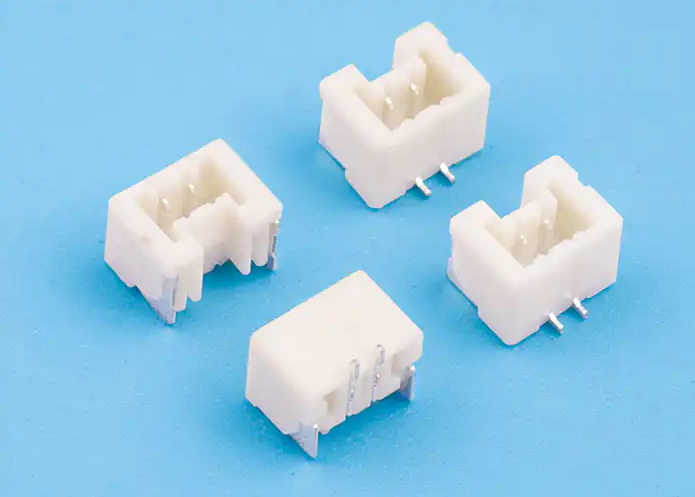Performance Analysis of Board to Board Power Connectors in High-Temperature Environments

The performance of Board to Board Power Connectors under high-temperature conditions is a critical consideration for industries where electronic components are subjected to thermal stress. These connectors are essential for establishing reliable electrical and mechanical connections between two printed circuit boards (PCBs), and their ability to withstand heat is paramount in ensuring the stability and longevity of electronic systems.
In the electronics manufacturing sector, Board to Board Power Connectors are designed to maintain their structural integrity and functionality even when exposed to high temperatures. The materials used in the construction of these connectors, such as high-temperature plastics and metals, are carefully selected to withstand thermal cycling and prolonged exposure to heat without degradation. This is crucial for applications in automotive, aerospace, and industrial electronics, where components may be exposed to elevated temperatures for extended periods.
The performance of Board to Board Power Connectors in high-temperature environments can be assessed through various parameters, including their ability to maintain a secure connection, resist corrosion, and manage heat dissipation. Connectors that are rated for high-temperature operation typically undergo rigorous testing to ensure they meet specific industry standards. These tests simulate the harsh conditions that the connectors will encounter in real-world applications, providing valuable data on their performance and reliability.
One of the key challenges faced by Board to Board Power Connectors in high-temperature scenarios is the expansion and contraction of materials due to thermal changes. This can lead to mechanical stress and potential failure of the connection. To combat this, manufacturers often incorporate design features such as flexible housings and reinforced contact points to maintain a secure connection even as the surrounding materials expand or contract.
Another critical aspect of high-temperature performance is the insulation resistance of the Board to Board Power Connectors. As temperatures rise, the insulating properties of materials can degrade, leading to a higher risk of electrical shorts or leakage currents. High-quality connectors are designed with materials that maintain their insulating properties even under extreme heat, ensuring the safety and efficiency of the electrical connections.
The contact resistance of Board to Board Power Connectors is also affected by high temperatures. As the connectors heat up, the resistance at the contact points can increase, which can lead to a drop in signal quality and power transfer efficiency. To mitigate this, connectors are often plated with materials that have low resistivity and can withstand high temperatures without significant performance degradation.
In addition to the physical properties of the connectors, the design of the mating surfaces also plays a role in the performance of Board to Board Power Connectors in high-temperature conditions. The mating surfaces must be designed to provide a secure connection that resists the effects of thermal expansion and contraction, as well as to facilitate efficient heat dissipation to prevent localized overheating.
Manufacturers of Board to Board Power Connectors continuously strive to improve their products' performance in high-temperature environments. This involves not only selecting the right materials but also optimizing the design to ensure that the connectors can operate reliably in a wide range of temperatures. By doing so, they can ensure that electronic systems remain functional and safe, even in the most demanding thermal conditions.
In conclusion, the performance of Board to Board Power Connectors in high-temperature environments is a complex issue that requires a deep understanding of materials science, engineering, and manufacturing processes. By carefully selecting materials and designing connectors to withstand the rigors of high-temperature operation, manufacturers can ensure that these critical components maintain their integrity and functionality, thereby protecting the reliability of the electronic systems they serve.
1、CKT: 2Pin
2、Current rating: 1A AC/DC
3、Voltage rating(max): 125V, AC/DC
4、Working Temperature: -25°C~+85°C,
(Including temperature rise in applying electrical current)
5、Contact resistance: value s20mΩ
After environmental testing≤30msΩ
6、Insulation resistance: 2100MΩ
7、Withstand voltage: 500VAC(rms)
8、Applicable PCB board thickness: 1.6mm to 2.0mm
- Questions and Answers
- Opinion
- Motivational and Inspiring Story
- Technology
- Live and Let live
- Focus
- Geopolitics
- Military-Arms/Equipment
- Güvenlik
- Economy
- Beasts of Nations
- Machine Tools-The “Mother Industry”
- Art
- Causes
- Crafts
- Dance
- Drinks
- Film/Movie
- Fitness
- Food
- Oyunlar
- Gardening
- Health
- Home
- Literature
- Music
- Networking
- Other
- Party
- Religion
- Shopping
- Sports
- Theater
- Health and Wellness
- News
- Culture

